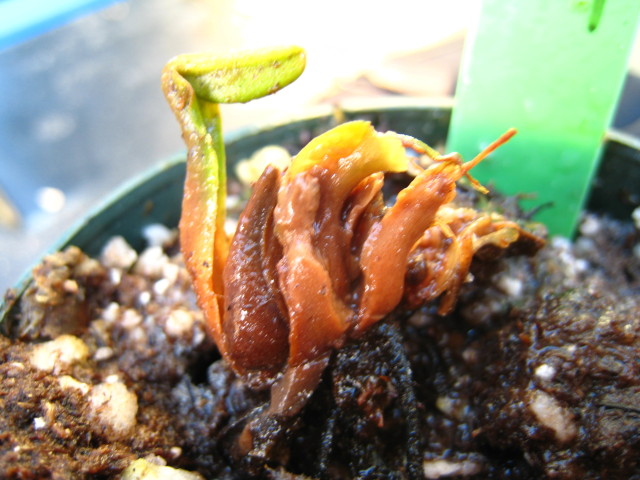Question
 Rotted Colorado Giant
Rotted Colorado Giant
Over the past three winters, I have had a problem with losing plants to some kind of rot. The winter before last, I lost several Venus Flytraps. Last winter, I lost almost all of my (many) remaining Venus Flytraps--only a few Red Dragons survived, albeit in a miniaturized form. Some other plants were affected as well, such as a S. Oreophila, a Judith Hindle, and some Florida Giant dewthread sundews, but these survived, although they were much reduced in size. Note that I have lived in my current location for eight years, and previously had never had any problems; I had never lost plants over the winter before. After the first experience of losing plants, the next winter I adjusted the water levels in the trays to be lower (In the past, I used to keep the water trays filled fairly high throughout the winter and as I stated, for five winters this did not cause any problems). As already mentioned, I lost even more plants this time around. This current winter I kept the water levels low AND frequently treated the plants with sulfur fungicide (Note, I replaced the lost plants last summer). While this year's results do not seem as bad as last year's disaster, I see that I have lost at least one Venus Flytrap to rot--a Colorado Giant. It's hard to tell, but a cupped flytrap may have succumbed as well. Also, the rot has affected another Judith Hindle pitcher plant, but as before, part of that plant appears to have survived. The rot causes the bulb or tuber to have a brownish appearance (picture attached). I considered that perhaps some of my potting media may have become infected with some kind of spores, but in fact the plants that were affected this year were ones purchased last summer that are still in the original pots; I have not yet repotted them. I cannot think of anything that has changed recently compared with the earlier years when I did not lose plants EXCEPT that I used to take my plants into the garage during a freeze. Per your advice, I stopped doing that, leaving them outside for the typical short freezes that we experience here (I'm in the Portland area). Could this be the cause of the problem? Any advice you could provide would be appreciated. Thank you.
AnswerHi Robert,
This one has me scratching my head a little. My best guess as to what is going on here has to do with micro-climate. It's really common around houses to have areas that stay much colder, and sometimes more prone to certain types of fungus. Where I used to live in North Portland I found that areas near the house that didn't receive much sun in the winter were also very prone to powdery mildew. You can also have areas that are more windy, so you get greater wind-chill. This can lead to rapid dehydration even though the temperatures may not be all that cold.
I noticed that the flytrap was still in a 3 inch pot. It will definitely help to get your plants in larger pots. Bigger pots tend to help with all sorts of ills. Having the plants more out in the open will help also.
If you could send me a couple photos of your area where you have your plants now. I'd like to see what the area looks like in comparison to other houses, yard, etc... Feel free to mark it as private if you don't want others to be able to view it in the archives. I'd like to follow up more with you on this. You can also send an e-mail via the website with your phone number and a good time to call you to discuss this more. Mention the conversation with me on Allexperts in the e-mail. If you're having this problem, chances are others are too. It's especially puzzling since we've had pretty mild winter here in the Northwest. We barely hit low 20's this year.
Good Growing!
Jeff Dallas
Sarracenia Northwest
http://www.cobraplant.com






